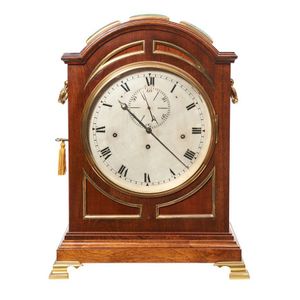Johnson Three Train Bracket Clock
You must be a subscriber, and be logged in to view price and dealer details.
Subscribe Now to view actual auction price for this item
When you subscribe, you have the option of setting the currency in which to display prices to $Au, $US, $NZ or Stg.
- Anchor Escapement - An anchor escapement is a type of mechanical escapement used in clocks and watches. It is a refinement of the older verge escapement, which was used in early mechanical timekeeping devices. The anchor escapement is characterised by the use of an anchor-shaped pallet that rocks back and forth, alternately locking and releasing the escape wheel. This action allows the movement of the watch or clock to be regulated, producing the characteristic tick-tock sound that is associated with mechanical timekeeping devices. The anchor escapement is generally more accurate and reliable than the verge escapement, and it is still used in many modern clocks and watches today.
- Broken Arch - An arch at the top of the clock, usually of half circle shape where the diameter is less than that of the frame from which it rises. The area in the broken arch may contain one or more subsidiary dials, the makers name, strike / silent mechanism, automata, phases of the moon or a painted scene. This design feature is found mainly on bracket clocks and longcase clocks.
- Back Plate - On many types of clocks, the movement operates between two plates, usually made of brass, one at the back, and the other at the front, which forms a mount for the dial.
On English bracket, mantle and table clocks the backplate was often visible through a glass door or panel from the late 17th century, and could be profusely engraved with scrolling decorations, flowers, foliage, birds, and figures. The engraving could also include the maker?s name.
The amount of engraving reduced and became simpler as the 18th century progressed, and by 1800, had been reduced to a border, often with the maker's name in the centre. By the early 1800s all decoration had ceased, and only the maker's name was added, and by the Victorian era, most bracket, mantle and table clocks had no engraving. - Mahogany - Mahogany is a dense, close grained red-coloured timber from the West Indies and Central America. It was first imported into Europe in the the early 18th century and its use continued through the 19th century. It was popular for furniture making because of its strength, the wide boards available, the distinctive grain on some boards, termed flame mahogany and the rich warm colour of the timber when it was polished.. The "flame" was produced where a limb grew out from the trunk of the tree, and this timber was usually sliced into veneers for feature panels on doors, backs and cornices.
Some terms used to describe mahogany relate to the country from which it originally came, such as "Cuban" mahogany, "Honduras" mahogany etc. However unless the wood has been tested the names assigned are more a selling feature, rather than a true indication of the timber's origin. - Circa - A Latin term meaning 'about', often used in the antique trade to give an approximate date for the piece, usually considered to be five years on either side of the circa year. Thus, circa 1900 means the piece was made about 1900, probably between 1895 and 1905. The expression is sometimes abbreviated to c.1900.
- Movement - The technical name for the workings of a clock or watch, and does not include the dial or case.
This item has been included into following indexes:
Visually similar items

Maples London Edwardian walnut bracket clock having brass bindings, a brushed metal face with Roman numerals, with keys. Condition: good, overall good order, needs a service, height 33 cm

Antique mahogany 'balloon' mantel clock

A George III table regulator clock, circa 1810, the break arch case with three brass trimmed rectangular glass panels set into the top of the arch. Circular cast brass bezel with brass inset panels above the dial and two brass inset panels below dial. Bras

A Regency mahogany bracket clock by J.M French, Royal Exchange, London, the rectangular case with radially gadrooned shallow caddy top with central acorn finial, rectangular side apertures with silk lined brass frets, the moulded plinth raised on scroll an
